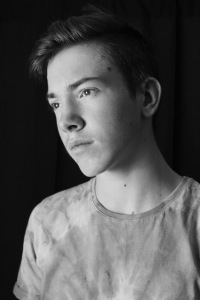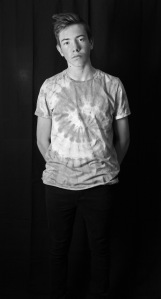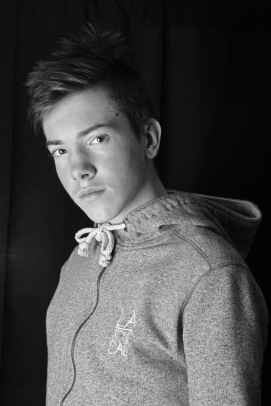The main goal for this exercise is to devise and then put into practice, a workflow that suits you personally, for a specific short assignment.
You have been asked to make this exercise a short portrait session, which will be limited in time. For this, you will need to find a suitable location and a model. You must then begin considering different poses for your model. They could vary in scale, from head shots, head and shoulder shots, three-quarter length shots to full length shots.
The important thing to remember when devising your workflow, is to remember that you will be taking a large number of images in a concentrated period of time. You should plan your work flow in advance and write it down as a flow chart. Follow this workflow for this exercise, however, you are able to depart from it if you find it restrictive or if you decide that your workflow has shortcomings.
When you have finished your shoot, write a short assessment of how suitable your planned workflow chart was. Say whether or not it helped you or if it needs some adaptation.
The editing or selection process will happen later, when you will examine the entire shoot on the computer. You will then look at images which contain the best facial expression, poses etc.
I will be dividing my workflow chart into three stages.
- Pre Photo Shoot
- During the photo shoot
- Post photo shoot
Before I began taking any portrait shots, I decided to research more into portrait photography, and research some well known portrait photographers, in order for me to gain more knowledge, which would hopefully influence my portraits. Whilst studying photography at A-Level, I was aware of the well known portrait photographers, as I have previously researched their work before, however, I wanted to go back and look over their work again, so I could pick up some ‘tips’ with poses or lighting, which I could incorporate into my work.
Taken from Photography by John Ingledew, Some photographers have a passion for people and a fascination for faces. Their natural subject is the portrait, but what makes a photograph of someone a portrait? A portrait attempts to express the character of a person and pin down the sitter in the hierarchy of their world, socially and physically, showing status, authority and significance. A portrait offers insight into a person beyond the details of appearance, revealing unknown sides of his or her character or showing a fresh perspective on someone we know well.
In today’s society, almost no one blinks an eye at having their portrait photograph taken. Taken from Photography The Key Concepts, by David Bate, While we may not like the look of our face on a passport photograph or identity card, we do readily recognize the importance of ‘looking right’ on those occasions were pictures matter personally. How we look to friends and family in photographs matter, especially in social rituals like weddings, birthday celebrations, religious ceremonies, vacation trips and meeting people on the Internet. This is because we know they are part of how people see each other.
Portrait photographs are typically made up of four key elements.
- The Face: This includes facial expressions, Hair, Smile, Make Up. – Personal Appearance.
The expression on a face in portraiture is crucial and can exert a considerable impact on how a portrait signifies meaning. An expression can have a dramatic impact, even with the slightest movement of the eyes or the mouth. The mouth is read as smiling, sad, angry, gaping, pouting etc. Eyes can seem alive, glaring, seductive etc. Facial expression can also indicate a certain mood that the persona is feeling, such as anger, sadness, frustration, melancholy, happy and joyful. However, the face it seems, is something to trust and distrust. Someone looking downwards might be showing piety or sadness, modesty or shyness, an example of this can be seen in portraits of Diana Princess of Wales, taken by photographer Mario Testino.

Diana, Princess of Wales, London, Vanity Fair 1997. By Mario Testino

Diana, Princess of Wales, London, Vanity Fair 1997. By Mario Testino
Whether the subject is smiling or frowning, looking happy or sad, we know that these are ‘expressions’ and are not necessarily a fixed state of being. Yet, for us the viewers of these portraits, we may still try to read beyond these surface characteristics, simply because we know hey are not a permanent state of the subject. They are temporary or are even merely masks.
- Pose: The subjects manner and attitude in the photograph
The pose of the sitter within a portrait photograph, is itself a visual argument, a form of rhetoric. The sitter may be standing upright, slumped in a chair, thinking, stern folded arms, laughing, hands on hips, such postures are ‘read’ in combination. It is the job of the photographer to spot or direct these combinations and poses, in order to understand and control what they signify together within that portrait.
Similar to the facial expressions within a portrait, the pose of the subject can also be misleading or untruthful. An ‘upright’ pose for example, may suggest that the subject is an ‘upright citizen’, although it could just mean that the subject is self conscious about being photographed. These characteristics are sometimes social and at other times psychological and to do with mood, or a combination of both. How a person carries their body, posture and conveys it in gesture, can be read as ’embodying’ their psychological attitude.
- Clothing and Accessories: Social class, Sex, Cultural values, Fashion and Trends
Clothing, or its absence, and the various accessories that go with it, for example, hats, jewellery, scarves, handbags, all contribute to the rhetoric of the portrait. Clothes can indicate a great deal about someone’s social identity and how they relate to it, in their pose. A uniform for example, can make it easily distinguishable between a doctor or nurse, someone in the military, a police officer or fireman.
Denim jeans, invented in America, can signify a ‘causal dress code’. They have become universal in value for being practical, hard wearing, worker quality. The body itself is caught up in the rhetoric of clothing as difference. Which part of the body is covered or uncovered, clothed or unclothed is crucial in fashion. Roland Bathes, for example, argued that fashion, eroticism, is located in the gap of clothes, the parts of the body that are revealed by fashion clothing. Each year, the fashion moves around, to emphasize different parts of the body. Cleavage for example, highlights or hints as to what is concealed within the garment.
- Location: Will it be taken on a plain background, Coloured background, Textured background, Social scene, In front of buildings, On the street etc.
The setting or background behind the sitter, whether in a studio or an everyday exterior or interior location, provides a context for the sitter. The location literally locates the sitter within a social place, and we as the viewers judge their position accordingly. Portraits set in studios or locations, allow a range of contexts, The Home can be (Posing in front of it, doing domestic work, relaxing, leisure time, gardening) The Workplace can be ( Industry, trade, profession, working).
Different types of portraiture, we might call them sub-genres, vary their emphasis on each of these components. Each element affects another in the overall potential for meaning. For example, a passport photograph is usually taken in front of a plain white background. The background serves as a way to make the face stand out, in order for the facial area to be scrutinized. With the combination of these key elements, the portrait photograph provides the aesthetic and rhetorical form from which the demands arises that the viewer reads the picture.
Eve Arnold.
Eve Arnold, an American photojournalist, born in Philadelphia, Pennsylvania to Russian immigrant parents. She began photographing in 1946, whilst working at a photo finishing plant in New York City. She studied photography in 1948 with Alexei Brodovitch at the New School for Social Research in New York.
Arnold first became associated with Magnum Photos in 1951, and became a full member in 1957. She quotes “If a photographer cares about the people before the lens and is compassionate, much is given. It is the photographer, not the camera, that is the instrument. ”
She is well known for photographing iconic figures, such as Marilyn Monroe, Queen Elizabeth II and Malcolm X. However, she also documented the lives of the poor, migrant workers and even protests. Taken from Marilyn Monroe, An Appreciation by Eve Arnold, Over a ten year period, from the early 1950’s until shortly before Marilyn Monroe’s death, the years in which she went from virtual anonymity to super stardom, photographer Eve Arnold had six photo sessions with her. The shortest was two hours: the longest continued for two months during the filming of The Misfits. Arnold and Monroe developed a strong friendship that was based on the camera, and now, our of the countless photographs she took, Arnolds has chosen those that most clearly reveal the Marilyn she came to know, a woman with imperfections and problems, and a daunting public image to sustain, but who was also possessed of humour, warmth and a formidable shrewdness. The result is in this book, composed of seventy two photographs, most of which have never been seen before, that given an exceptional insightful view into what being photographed meant to Monroe, as well as what it was like to photograph her.
In her rich, perceptive text, the author explains what she saw through the lens: The savvy with which Marilyn approached being photographed, moving, posing and composing herself, with am instinctual understanding and love of the camera’s eye.
Her most well known photographs of Monroe, are those whilst she was on the set of the film ‘The Misfits’ in 1961. Magnum Photos arranged for the exclusive rights to all still photographs on the film. Therefore, Magnum Photos were permitted to take photographs not only during filming, but for any picture stories the actors might agree to do away from the location. The first two Magnum Photographers to photograph the film was Henri Cartier-Bresson and Igne Morath. Monroe flirted and played up to Cartier-Bresson, but was simple and sweet to Morath. Cartier-Bresson left a taped interview about Marilyn and his experience with The Misfits, he quotes “ I saw her bodily, Marilyn, for the first time and I was struck as by an apparition in a fairy tale. Well, she’s beautiful, anybody can notice this, and she represents a certain myth of what we call in France ‘La Femme Eternelle’. On the other hand, there’s something extremely alert and vivid in her, an intelligence. It’s her personality, it’s a glance, it’s something very tenuous, very vivid, that disappears quickly, that appears again. You see, it’s all of these elements of her beauty and also her intelligence that makes the actress not only a model but a real woman expressing herself”.
The Misfits

1. Marilyn Monroe on the set of ‘The Misfits’, Nevada, USA 1960. Eve Arnold.
In my opinion, this photograph shows Monroe as being very vulnerable. Her eyes show some sort of sadness, and it seems as though she was caught unaware when this photograph was taken. She looks tired. This isn’t a ‘Posed’ or ‘Staged’ portrait, this is a genuine photograph of Monroe and shows her real expression, not a put on one.
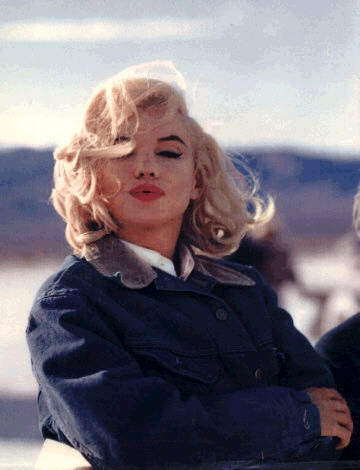
2. Marilyn Monroe, on the Nevada desert during the filming of ‘The Misfits’, Nevada, USA 1960. Eve Arnold.
I also believe this is was a photograph of Monroe, taken as she was unawares. Her pouting expression is very cheeky and appears to be an almost fast response to being caught unaware by the camera.
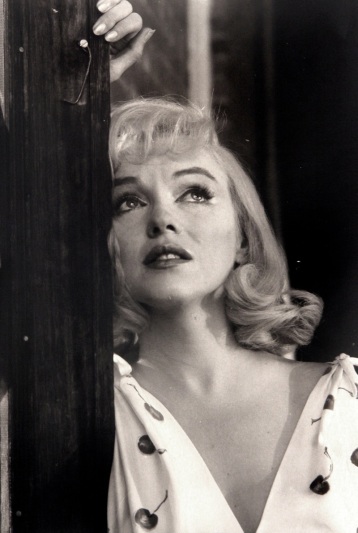
3. Marilyn Monroe on the set of ‘The Misfits’, Nevada, USA 1960. Eve Arnold.
I believe this appears to be a photograph taken whilst Monroe was acting, however, if we as viewers didn’t know that she was acting in this photograph, you would honestly believe that she was photographed whilst genuinely being upset. Being in monochrome, Arnold has taken away any distractions of colour and background, and has enabled us as the viewers to focus more on Monroe’s facial expression and emotion.

4. Marilyn Monroe, Studio Sessions. Los Angeles, USA 1960. Eve Arnold.
I really like this photograph. Again, keeping it in monochrome, Arnold has made Monroe’s black dress almost disappear into the background. Monroe’s pale skin jumps out of the dark surroundings, and you as the viewer are drawn into her smile. It does feel like a staged portrait photograph, however, she does look comfortable.

5. Marilyn Monroe, Studio Sessions. Los Angeles, USA 1960. Eve Arnold.
This is an unusual portrait photograph, a unique composition. Photographing Monroe from behind is interesting as she is a famous actress and you would assume that everyone wants to see her face on, however, Arnold has chosen to photograph her semi naked, exposing Monroe, making her vulnerable and ‘real’. Roland Bathes argued that fashion and eroticism is located in the parts of the body that are revealed by clothing. Therefore, for some, this can be seen as being very erotic or provocative, however, I believe this is a very revealing and exposing photograph.
Arnold has managed to capture Monroe laughing at someone towards the side of the frame, making this photograph less serious and more mischievous, yet still keeping the sexual element with her being semi naked.

6. Marilyn Monroe, on the set of ‘The Misfits’, Nevada, USA 1960. Eve Arnold.
This appears to be a photograph taken whilst Monroe was not filming, but taking a break. It is a very fun photograph and Monroe seems to genuinely be happy. She doesn’t appear to be looking directly at the lens, and there seems to be something blocking the frame on the left hand side. It is as though Arnold either snapped this photograph quickly with Monroe unaware, hence why something has been accidently included in the frame, or someone may have walked into the shot. But why not remove the distraction? Perhaps Arnold wanted to keep the mistake in the shot, in order to show that this was a genuine portrayal of the real Monroe, and by removing it, could be seen as manipulation, thus leading to the question as to whether or not Monroe was her genuine self at this moment in time when this photograph was taken, or if she was posing for the camera.
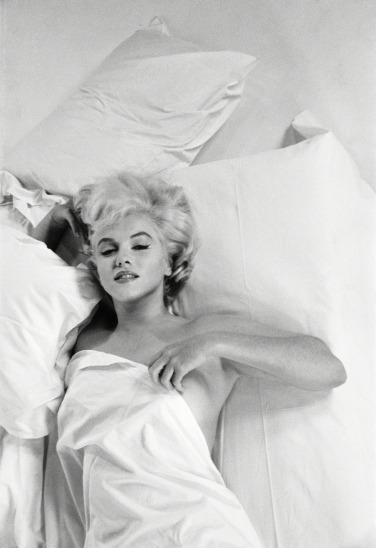
7. Marilyn Monroe, Resting between takes during a photographic studio session, Filming The Misfits. Hollywood, USA, 1960. Eve Arnold
This in my opinion is a photograph which shows the real Monroe. Sleeping or resting whilst naked is an intimate thing, and by allowing Arnold to photograph her, Monroe must have felt comfortable. Being comfortable with each other, means that Monroe didn’t have to play up to or pose in front of the camera, whilst Arnold was photographing her. She could be herself.

8. Marilyn Monroe, on the set of ‘The Misfits’, Nevada, USA 1960. Eve Arnold
This again appears to be a photograph taken of Monroe whilst she was unaware. However, she appears to be looking off into the distance. Perhaps looking at fellow actors on the set. Or perhaps she was looking off into the surroundings of the desert. We will never know what Monroe was looking out to, and I think that is what makes this a lovely photograph. Arnold has used a head shot, to draw as much focus to Monroe’s facial expression. With this photograph, we as viewers want to know what she was looking at, at the time this was shot, and how she was feeling, because she appears to be happy.

9. Marilyn Monroe, Studio Sessions. California. Los Angeles. USA, 1960. Eve Arnold
In regards to this photograph, an outstretched hand is adjusting Monroe’s hairstyle, as she glances back towards the camera for reassurance. In 1960, stardom was just beginning to be looked on as a contrivance and as an affront to personality. Monroe was interpreted at the time to be as both a victim of that system and also as a representative. In 1962, she protested, ” I do not consider myself a kind of merchandise but I am sure that many people do not see anything else in me… That is what annoys me: A sex symbol becomes an object. I hate being an object” Unlike the colour version of this photograph above, Monroe appears to be nervous and concerned in this photograph, even though you can’t see her full expression due to the hand being in the way. Perhaps she was nervous and looked back for reassurance from Arnold to make sure that she looked ok or was sat in the right way. Who knows, perhaps the assistant made her laugh to steady her nerves, hence why she is laughing in the colour version of this photograph.
I have always loved Arnold’s portraits of Marilyn Monroe, and I myself own a few prints of them. I particularly love the black and white portraits of Monroe, as I feel that black and white portraits remove any distractions caused by the colours of the clothing and backgrounds, allowing you to concentrate more on the persons facial expression and body language. Arnold’s photographs of Monroe, show her in a way that people had never seen her before. The private side to Monroe. We as the viewers get to see Monroe behind the scenes at film sets, and her personal life. Arnold was able to capture Monroe’s emotions in her photographs, extremely well. I have noticed that Arnold photographs not only full length shots of Monroe, but also shoots a lot of head shots or half body shots. With head shots and half body shots, you are able to see the Monroe’s facial expressions better and are therefore able to see any emotion in Monroe’s eyes, especially in the photographs, 1&3 of Marilyn Monroe on the set of ‘The Misfits’, Nevada, USA 1960. Eve Arnold. These two photographs have an almost hidden story behind them, and you wonder what Monroe was looking at, or thinking at the time these photographs were taken.
In regard to the photographs Number 2, Number 6 and Number 7, You can really tell that Monroe felt comfortable around Arnold. Monroe shows her personality in these photographs, and doesn’t seem to be ‘posing’ for the camera or film, she seems to be portraying her normal self. This is something I definitely want to capture in my portraits. I don’t want my photographs to show my model being un comfortable. I will take some tips from Arnold’s work and try to incorporate it into my portraits.
Bert Stern.
Bert Stern was a well known, self taught, American commercial photographer. He worked on portrait photography, as well as fashion photography. He too has photographed many iconic figures such as Marilyn Monroe, Audrey Hepburn, Elizabeth Taylor and Madonna. His most famous series of photographs, was that of Marilyn Monroe. He published the book ‘The Last Sitting’ in 1982, which included 2,500 photographs, which had been commissioned for Vogue, of Monroe, which had been taken over a 3 day period, only 6 weeks before her death. Stern quotes ” … recounted being enchanted by Monroe until a near-intimate encounter after the second day of shooting; he then realized that she was deeply troubled” The collection also includes the contact sheets, with images Monroe had disliked and crossed out.
Stern quotes “I took audacious pictures that got people to want things,”

1. Marilyn Monroe, From “The Last Sitting,” 1962 (Diamonds). Bert Stern.
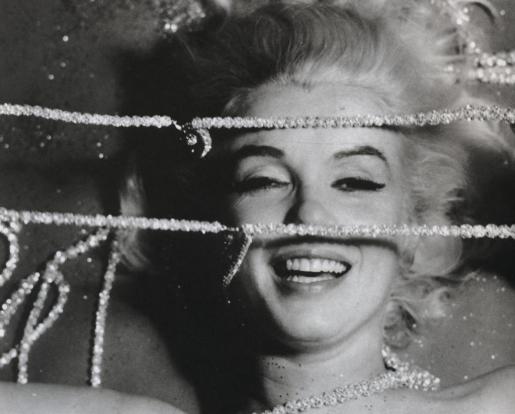
2. Marilyn Monroe, From “The Last Sitting,” 1962 (Diamonds). Bert Stern.

3. Marilyn Monroe, From “The Last Sitting,” 1962 (Diamonds). Bert Stern.
Stern’s portraits of Monroe, are different to those taken by Eve Arnold. Stern has captured Monroe flirting with the camera, she playfully taunts us the viewers, with the jewellery. She is in other words, posing for the camera. Unlike several of Arnold’s photographs, where Monroe has been captured unawares. She looks ‘happy’ in the photographs above, however, as mentioned previously at the beginning of this exercise, just because someone is smiling, doesn’t meant that this is how they are feeling. Smiles can be false and put on, just like a frown or a pouting expression.
However, similar to Arnold’s photographs 9. Marilyn Monroe, Studio Sessions, and 7. Marilyn Monroe, Resting between takes during a photographic studio session, Stern has managed to capture Monroe in the portraits below, looking very vacant and sad. I have seen Stern’s portraits of Monroe very frequently, and I have to admit, I felt a different feeling when looking at his portraits, to those that were taken by Eve Arnold. Monroe is obviously posing for the camera, and has probably been told how to position her hands and arms, and where to look, by Stern. However, her facial expressions and her eyes, show tiredness, sadness and she has a vacant stare. It’s almost as though she was ‘Going through the motions’, posing and smiling for the camera, but there was no life or feeling in her eyes.
I don’t believe that this is an emotion or an expression that someone can falsify nor ‘put on’. I genuinely believe that he has captured just how she was feeling at that moment in her life. We must remember that these portraits were taken only 6 weeks prior to Monroe’s death.

1. Marilyn Monroe: From “The Last Sitting” 1962. Bert Stern.
Similarly to Eve Arnold’s portrait, 4. Marilyn Monroe, Studio Sessions, Stern has chosen to photograph Monroe against a simple, plain background. The choice for Monroe to wear this beautiful black dress can be seen to show her somewhat in mourning. Especially in photograph 2. Choosing to convert these portraits to monochrome was a good idea, as I believe that monochrome portraits enable the emotion from the sitter, to show through more. You are less distracted by colours or patterns in the clothing or make up, thus meaning that you can focus more on the facial expressions and posture. The black dress can be seen to be used in order to remove distractions from any pattern or colour, and the largeness of the black dress, helps to frame her, and guides our eye line up towards her face, in order for us to view her facial expressions.

2. Marilyn Monroe: From “The Last Sitting” 1962. Bert Stern.

3. Marilyn Monroe: From “The Last Sitting” 1962. Bert Stern.
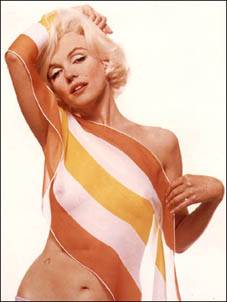
4. Marilyn Monroe: From “The Last Sitting” 1962. Bert Stern.
I find these colour portraits, very ‘retro’, especially with the colour saturation. I prefer Stern’s monochrome portraits, to these colour portraits. With both of these colour portraits, you can see similarities between her expressions in the monochrome photographs. Even with these photographs, Monroe seems to be vacant and sad.

5. Marilyn Monroe: From “The Last Sitting” 1962. Bert Stern.
Stern included the contact sheets, which included photographs that had been crossed out by Monroe herself. Unlike digital photographs, where you can make The technical edit. (Remove any images which are faulty), The Selects and The First Selects, on your computer and processing software, Stern’s technical edits and selections were done on the contact sheets, in order for Monroe to ‘see’ all of the photographs taken during the photo shoot. In the photographs below, you can see that Monroe crossed out numerous amounts of photographs that were taken during this photo shoot. But why did Monroe cross out so many? What did she find wrong with these portraits? Unfortunately, we will never know.
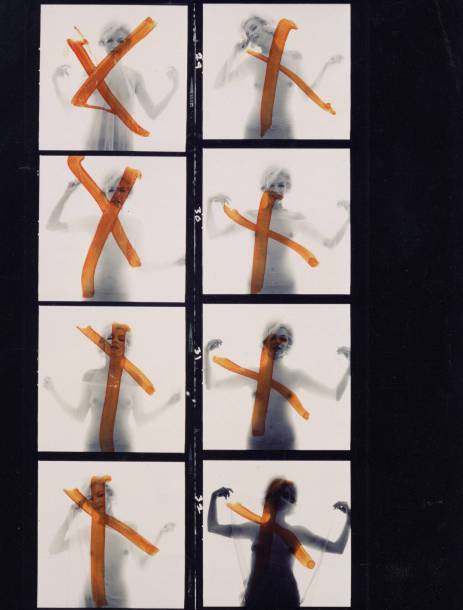
1. Marilyn Monroe: From “The Last Sitting” 1962. Crossed out contact sheets. Bert Stern.

2. Marilyn Monroe: From “The Last Sitting” 1962. Crossed out contact sheets. Bert Stern.
Stern, like Arnold, uses a variety of head shots, 3/4 shots, and full length shots. However, the more striking are those that are the head or 3/4 shots. He also uses colour photographs, as well as monochrome. I like both, however, similarly to Arnold’s, my personal preference are his monochrome portraits.
David Bailey

Photographer David Bailey
David Bailey is regarded as one of the ‘Nation’s best’ photographers. Bailey is a well known British fashion and portrait photographer. He was contracted to British Vogue in the 1960′s. During the 60′s, Bailey undertook a large amount of freelance work, where he socialised with celebrities, royalty, rock stars and many more. In 1964/1965, he produced a ‘Box’ of portraits, called Box of Pin-Ups. The box contained poster prints of well known, famous individuals, such as Andy Warhol, Terence Stamp, The Beatles, Mick Jagger and The Kray Twins.

Box of Pin-Ups, 1965. David Bailey.

The Beatles. Box of Pin-Ups, 1965. David Bailey.
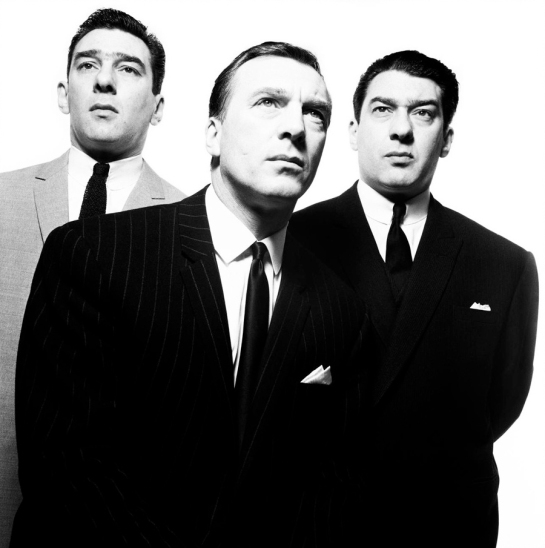
The Kray Brothers. Reggie Kray (Left) Ronnie Kray (Right). Box of Pin-Ups, 1965. David Bailey.
With the portrait of the Kray Brothers, I notice that Bailey photographs them standing ‘upright’. As mentioned above, when a photographer shoots a portrait with the person standing ‘upright’, they could be suggesting that the model is an ‘upright citizen’, or because they feel uncomfortable being photographed. I feel that this statement is completely wrong in regards to the Kray Brothers portrait. The Kray Brothers were well known gangsters and criminals, how then can they be represented as being upright citizens?
Bailey photographs a half body shot, and at an angle. He somewhat positions them going down in size height wise. Perhaps he knowingly did this to suggest where the ‘power’ was in each specific individual. With their military like poses, arms behind their backs, they appear to be powerful and not to be messed with. With theses poses and the positioning of them in this photograph, Reggie Kray on the left appears to be the more dominant one, whereas Ronnie Kray on the right appears to be less dominant.
This can also be seen in the portrait below. It reminds me of a ‘selfie’. Ronnie Kray in the foreground, with the more dominant Reggie Kray looking over his shoulder, as if to ‘Keep an eye’ out.

The Kray Brothers, Reggie Kray (Left), Ronnie Kray (Right). Box of Pin-Ups, 1965. David Bailey.
One noticeable element of Bailey’s portraits, is that he converts them all to monochrome. By doing so, he removes any distractions caused by colours and patterns, enabling us the viewers, to concentrate more on the subjects body language, poses and facial expressions, texture, details and shapes also become more sharper and defined, enabling you to see things that would have been missed in a colour portrait. In my opinion you are able to read a monochrome portrait better than a colour portrait. Similarly to Eve Arnold and Bert Stern, Bailey uses a mixture of head shots, 3/4 shots and full length shots, however, he uses the head shots or 3/4 more than full length. Another striking thing with his portraits, is that not many, if only a handful, contain the model smiling. The rest seem to show the model stern faced. I wonder if Bailey preferred them not to be smiling, or whether it was down to the certain individual to decide how they wanted to ‘express’ themselves.
Overall Opinion:
John Ingledew, Photography. Laurence King Publishing, London, 2005. Telling the story of war, Pages 28-37
ISBN: 9781856694322
Photography: The Key Concepts. David Bate. Bloomsbury, London 2009.
Pages 67-80.
ISSN:1747-6550
ISBN:978-1-8452-0667-3
The Photograph, Graham Clarke. Oxford University Press, London 1997. Page 101
ISBN: 9780192842008
Diana, Princess of Wales, London, Vanity Fair 1997. By Mario Testino.
Arnold, Eve.
Marilyn Monroe, An Appreciation by Eve Arnold. Hamish Hamilton, London 1987.
ISBN: 024112381x
The Photography Book, Phaidon Press Limited, London 1997. Eve Arnold, Page27
ISBN: 071483937x
1. Monroe on the set of ‘The Misfits’, USA. Nevada 1960. Eve Arnold.
2. Marilyn Monroe, on the Nevada desert during the filming of ‘The Misfits’, Nevada, USA 1960. Eve Arnold.
3. Marilyn Monroe on the set of ‘The Misfits’, Nevada, USA 1960. Eve Arnold.
4. Marilyn Monroe, Studio Sessions. Los Angeles, USA 1960. Eve Arnold.
5. Marilyn Monroe, Studio Sessions. Los Angeles, USA 1960. Eve Arnold.
6. Marilyn Monroe, on the set of ‘The Misfits’, Nevada, USA 1960. Eve Arnold.
7. Marilyn Monroe, Resting between takes during a photographic studio session, Filming The Misfits. Hollywood, USA, 1960. Eve Arnold
8. Marilyn Monroe, on the set of ‘The Misfits’, Nevada, USA 1960. Eve Arnold
9. Marilyn Monroe, Studio Sessions. California. Los Angeles. USA, 1960. Eve Arnold
Stern, Bert.
1. Marilyn Monroe, From “The Last Sitting,” 1962 (Diamonds). Bert Stern.
2. Marilyn Monroe, From “The Last Sitting,” 1962 (Diamonds). Bert Stern.
3. Marilyn Monroe, From “The Last Sitting,” 1962 (Diamonds). Bert Stern.
1. Marilyn Monroe: From “The Last Sitting” 1962. Bert Stern.
2. Marilyn Monroe: From “The Last Sitting” 1962. Bert Stern.
3. Marilyn Monroe: From “The Last Sitting” 1962. Bert Stern.
4. Marilyn Monroe: From “The Last Sitting” 1962. Bert Stern.
5. Marilyn Monroe: From “The Last Sitting” 1962. Bert Stern.
Bailey, David.
Box of Pin-Ups, 1965. David Bailey.
The Beatles. Box of Pin-Ups, 1965. David Bailey.
The Kray Brothers. Box of Pin-Ups, 1965. David Bailey.
















